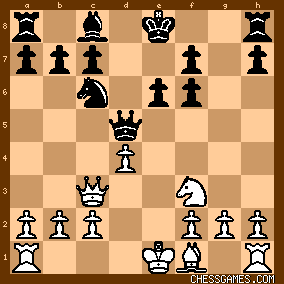KEG: A short but exciting draw.
Marshall, as in all his other games as Black in this match, played the French Defense. Lasker again played 4. Bg5, and another McCutcheon resulted. In a sharp position, Lasker elected to force a draw. 1. e4 e6
2. d4 d5
3. Nc3 Nf6
All seven games in this match in which Marshall had Black began this way. 4. Bg5
Lasker had played 4. Bd3 in Game 2. He switched to 4. Bg5 in Game 4, here in Game 6, and in Games 8 and 10, but reverted to 4. Bd3 in Games 12 and 14. 4... Bb4
Marshall played this (i.e., the McCutcheon) in all four games in the match in which Lasker played 4. Bg5. 5. exd5
Lasker had played 5. e5 in Game 4 (a draw), but tried 5. exd5 here and in Games 8 and 10. 5. e5 is probably the most forcing and effective variation for White. But contemporary reaction said otherwise: "A deviation from the tedious continuation e5. It [5. exd5] leads to an interesting attack." (Teichmann) 5... Qxd5
The normal line. The alternatives (5...exd5 and 5...BxN+) are entirely playable, but rarely tried. 6. BxN
Best, though relatively new at the time.
6... gxB
6...BxN+ (saddling White with doubled c-pawns) is almost certainly stronger. 7. Qd2

click for larger view7. Qd3 and 7. Nge2 are about equally good. The most aggressive line is 7. Qg4, but it can lead to wild play. In this match, Lasker was able to grind Marshall down, and thus avoided moves such as 7. Qg4. 7... BxN
"If Black had made the apparently better move of 7...Qa5, White could have secured a good game by 8. Nge2, g3, Bg2, and 0-0-0." (Tarrasch)(see also similarly Teichmann) Tarrasch (and Teichmann) was almost certainly correct that the text was superior to 7...Qa5, but the latter was hardly a mistake, and White's edge after 7...Qa5 8. Nge2 is minimal. Perhaps White's best play after 7...Qa5 is the flexible 8. Bd3. 8. QxB
"If 8. bxB, Black would probably get the better game with 8...c5!." (Teichmann) Both the text and 8. bxB are entirely playable. And if 8. bxB c5 White owns what advantage exists with 9. Nf3. After 8. bxB, best is 8...e5 or 8...Nc6 with approximate equality. 8... Nc6
9. Nf3
Lasker could also have played 9. 0-0-0 immediately. After 9. Nf3, the position was:

click for larger viewThis same position was also reached in Games 8 (won by Lasker) and 10 (another draw). 9... Rg8
"9...Rg8 is the best move in the game." (<Knight 13>). In games 8 and 10, Marshall varied with 9...Qe4+. Schlechter called 9...Qe4+ "rather better." Lasker, however, secured an edge in Games 8 and 10 after 9...Qe4+ with 10. Kd2. All in all, I think <Knight 13> has the better of the argument with Schlechter here. 9...Rg8 is very sharp, and the ensuing play is quite exciting. 10. 0-0-0

click for larger view"A spirited pawn sacrifice which gains for White a violent attack." (Tarrasch). While Tarrasch's observation here is spot on, I must dissent from Moran's suggestion that 10. a3 would lead to trouble for White. Moran's analysis of 10. a3 (a perfectly acceptable line that is considerably less "violent than Lasker's 10. 0-0-0) is simply wrong: 10...Qe4+ [this gives White a small edge, better and equalizing would be 10...b5 or 10...Bd7] 11. Kd2 [Much better is 11. Qe3, which gives White the edge] 11...Bd7 12. Re1 Qf4+ [better would be 12...Qd5 or 12...Qf5] 13. Qe3 Qd6 14. Kc1 0-0-0 15. g3 Ne7 (15...Kb8 or 15...h5 were better) 16. Bg2 [weak, 16, Bd3 should be played and give White some edge) Bc6 17. Rd1? [awful, White would be OK after 17. Qd3] Nd5 18. Qd2? [18. Qh6 would be White's best chance] Nf4 with a win for Black (19. gxN RxB) only because of the poor analysis and suggested White moves by Moran. Thus, 10. a3 would have been OK. But Lasker's 10. 0-0-0 (after Marshall's 9...Rg8) made this game the tactical gem it turned out to be. | 




